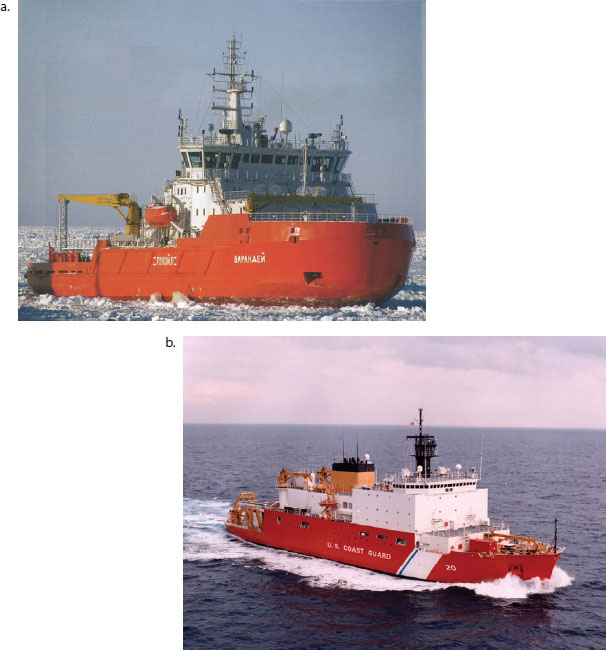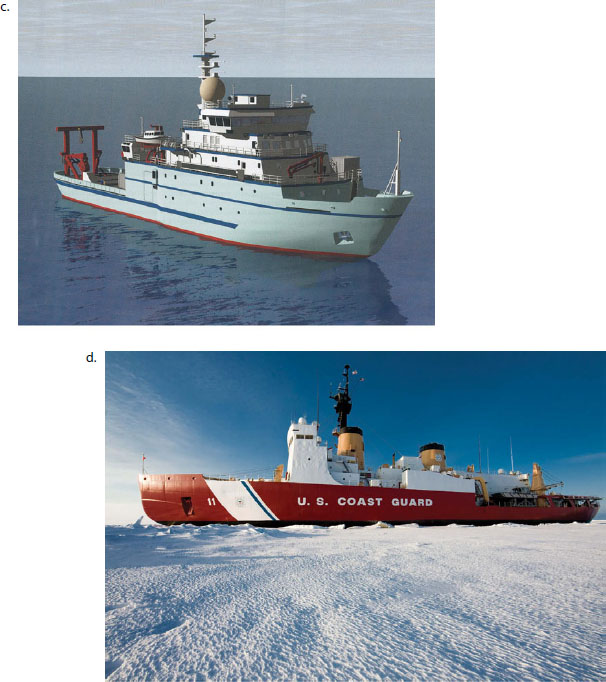Icebreaking Polar Research Vessels and Heavy Icebreakers
As outlined in this report and in previous National Research Council reports (NRC, 2007b, 2011c, 2011e), many of the proposed research activities of the next 20 years depend on having polar research vessel support in partially and fully ice-covered seas.1 This includes setting and retrieving moorings for ocean and sea ice observations, as well as launching and retrieving autonomous underwater vehicles. Furthermore, a useful observing system will need to operate during the Austral winter, where icebreaker penetration of the winter icepack is the only feasible method for enabling a monitoring program in and near the ice shelves. Helicopters, which might be able to assist in some of this workload, are limited in range and in all-weather Antarctic navigation. In addition, the annual resupply (“break-in”) of McMurdo Station requires the services of a heavy icebreaker. This resupply is essential for the functioning of the majority of U.S. research operations in Antarctica.
Despite this importance, the icebreaking capabilities of the United States are severely limited. As concluded by the 2007 NRC report (National Research Council, 2007b), “both operations and maintenance of the polar icebreaker fleet have been underfunded for many years, and the capabilities of the nation’s icebreaking fleet have diminished substantially.” The U.S. icebreaker capacity is limited to one polar research icebreaker, USCG Healy (Figure D.1(d)), and a privately owned research light icebreaker leased by the NSF, the Nathaniel B. Palmer. In addition, the NSF leases an ice-reinforced vessel, the Laurence M. Gould, primarily dedicated to support research operations in the Antarctic Peninsula area. The status of the icebreaker capabilities of the United States has been discussed in several previous NRC reports (National Research Council, 2007b, 2011c, 2011e), by a congressional analysis (O’Rourke, 2011), and in a Homeland Security audit (Richards, 2011). This issue involves both the U.S. Coast Guard (USCG) and NSF, and the history of authority over support for the Coast Guard heavy icebreakers (USCG and NSF, 2005). As outlined in these documents, there are strong national security and operational reasons for the United States to develop its own ice
________________
1The icebreaking polar research vessel (PRV) targeted by the science community differs from a heavy icebreaker. The former is essentially a research vessel specifically designed to configurably perform a broad range of scientific activities in partially or fully ice-covered seas. A heavy icebreaker, as the name suggests, is a vessel with high horsepower and displacement designed to break ice in the most extreme circumstances.
breaking capability for use in both the Arctic and the Southern Ocean. As concluded by the 2011 NRC report National Security Implications of Climate Change for U.S. Naval Forces, “future U.S. national icebreaker assets should be defined as part of a holistic force structure that also accommodates ongoing National Science Foundation-sponsored polar research needs.”
Icebreakers that can navigate in multiyear ice of Antarctica represent one of the most expensive infrastructures for Southern Ocean oceanographic and biological research and for access to coastal regions of East Antarctica as well as stations in West Antarctica and the vital resupply route to McMurdo. There are several options if the United States wishes to pursue its own national icebreaking capability. The range of heavy icebreaking capabilities appropriate for Antarctica year-round operations is PC 1 to PC 3 (classifications of icebreakers by icebreaking capabilities are shown in Table D.1). Ships, such as the Varandey (Figure D.1[a]), that can break ice, tow small icebergs, and clear harbors have construction costs of about $100 million, but they cannot adequately support research missions, act as helicopter platforms, or perform the McMurdo break-in. Replacement costs for each of the currently disabled U.S. Coast Guard heavy icebreakers, the Polar Sea and Polar Star, could be more than $700 million each with a construction time over 3 years after the funds are authorized. Less expensive modern research vessels strengthened for the ice such as the Sikuliaq (Figure D.1[b]), which is currently under construction for Arctic research, cost about $150 million and have capabilities to support research in unconsolidated seasonally light sea ice conditions and with limited endurance because of their smaller size. Specifications for NSF’s new icebreaking Polar Research Vessel are currently under consideration by the University–National Oceanographic Laboratory System (UNOLS). The United States should explore options of various-sized icebreakers within a holistic fleet plan. The daily costs for research ship operations as evaluated by UNOLS in 2010 and 2011 is approximately $31,000, and the expected daily costs for a polar class (PC1-PC3) heavy icebreaker will be greater than $40,000.
Other alternatives for icebreaker support over the next 20 years include partnerships with other countries and leasing icebreakers flagged by other countries. For the past five seasons, the United States has leased the services of the Swedish ice breaker, Oden, to do the annual break-in to McMurdo Station. The international fleet of nonnuclear ships capable of penetrating ice fields heavier than first-year ice is very limited in number, and many of those ships have more than 30 years of service. Currently, there is a shortage of modern heavy icebreakers in all polar regions. Acquisition and operation of these platforms are very resource intensive. Thus, sharing icebreakers between two or more nations could be considered for the future. The model of sharing special-purpose research vessels has proven successful for scientific ocean drilling

FIGURE D.1 Examples of the attributes of a variety of icebreakers: (a) Russian (Lukoil, Ltd.) icebreaker Varandey, service ship, length 100 m, maximum power 16.8 MW from two azmuthing electric pods; (b) U.S. Coast Guard icebreaker Healy is designed for heavy ice and polar research missions of NSF, length 130 m and maximum power 22 MW; (c) NSF (University of Alaska, Fairbanks) owned Sikuliaq, research light icebreaker (PC6-7) to be launched in 2013; (d) USCG Polar Sea/Star, length 122 m, maximum power 45 MW (60,000 hp); in repair to 2013. SOURCES: (a) Chenghui, 2011, (c) Edgar, 2011, both reprinted with the permission of the Society of Naval Architects and Marine Engineers (SNAME); (b) and (d) U.S. Coast Guard.

TABLE D.1 Polar Class Descriptions
| Polar Class | General Description |
| PC1 | Year-round operation in all polar waters. |
| PC2 | Year-round operation in moderate multiyear ice conditions |
| PC3 | Year-round operation in second-year ice with old ice inclusions |
| PC4 | Year-round operation in thick first-year ice that may contain old ice inclusions |
| PC5 | Year-round operation in medium first-year ice with old ice inclusions |
| PC6 | Summer/autumn operation in medium first-year ice with old ice inclusions |
| PC7 | Summer/autumn operation in thin first-year ice with old ice inclusions |
SOURCE: International Association of Classification Societies Ltd.
(e.g., Joides Resolution), and a case can be made that modern heavy icebreakers could be operated in a similar fashion. A first step toward shared use of heavy icebreakers could be a barter system. Ship time on heavy icebreakers could be bartered against ship time on other heavy icebreakers (this could prevent long transit times to the Southern Ocean or mismatch of icebreaking capacity for specific projects) or on open-ocean vessels. Such bartering agreements are working well in Europe. On the other hand, a U.S.-flagged polar heavy icebreaker with capabilities for year-round operations in Antarctica in combination with a dedicated icebreaking polar research vessel does anticipate requirements for the next 20 years of science in the Southern Ocean, U.S. responsibilities for Antarctic stewardship, and U.S. responsibilities for U.S. interests and the safety of U.S. personnel in Antarctica.
This page intentionally left blank.






